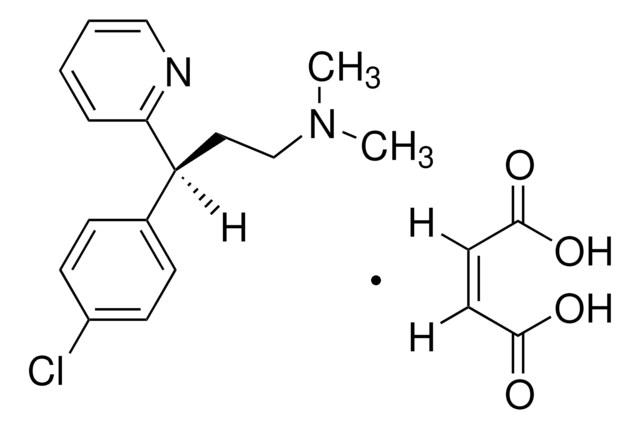C4915
S-(+)-Chlorpheniramine maleate salt
Sinônimo(s):
(S)-γ-(4-Chlorophenyl)-N,N-dimethyl-2-pyridinepropanamine maleate salt
About This Item
Produtos recomendados
Formulário
powder
originador
Bayer
cadeia de caracteres SMILES
[H]\C(=C(/[H])C(O)=O)C(O)=O.CN(C)CC[C@@H](c1ccc(Cl)cc1)c2ccccn2
InChI
1S/C16H19ClN2.C4H4O4/c1-19(2)12-10-15(16-5-3-4-11-18-16)13-6-8-14(17)9-7-13;5-3(6)1-2-4(7)8/h3-9,11,15H,10,12H2,1-2H3;1-2H,(H,5,6)(H,7,8)/b;2-1-/t15-;/m0./s1
chave InChI
DBAKFASWICGISY-DASCVMRKSA-N
Informações sobre genes
human ... HRH1(3269)
Procurando produtos similares? Visita Guia de comparação de produtos
Descrição geral
Aplicação
Ações bioquímicas/fisiológicas
Chlorpheniramine maleate is clinically used as a topical ointment to treat skin disorders such as sunburn, urticaria, angioedema, pruritus and insect bites.
Características e benefícios
Aplicação
produto relacionado
Palavra indicadora
Danger
Frases de perigo
Declarações de precaução
Classificações de perigo
Acute Tox. 3 Oral
Código de classe de armazenamento
6.1C - Combustible acute toxic Cat.3 / toxic compounds or compounds which causing chronic effects
Classe de risco de água (WGK)
WGK 3
Ponto de fulgor (°F)
Not applicable
Ponto de fulgor (°C)
Not applicable
Equipamento de proteção individual
Eyeshields, Faceshields, Gloves, type P2 (EN 143) respirator cartridges
Escolha uma das versões mais recentes:
Já possui este produto?
Encontre a documentação dos produtos que você adquiriu recentemente na biblioteca de documentos.
Chromatograms
application for HPLCapplication for SFCNossa equipe de cientistas tem experiência em todas as áreas de pesquisa, incluindo Life Sciences, ciência de materiais, síntese química, cromatografia, química analítica e muitas outras.
Entre em contato com a assistência técnica






